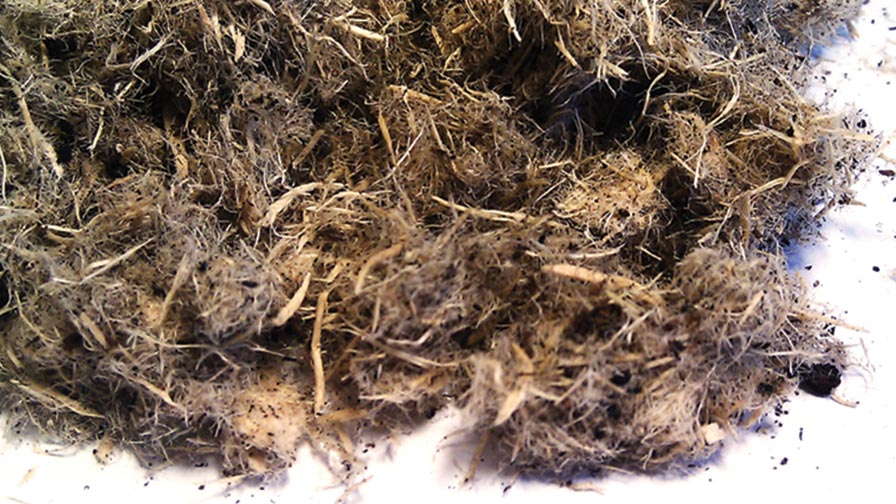Problems With Your Growing Media? Suppliers Have Answers
 Production challenges can come up at any time in the greenhouse, and that includes making sure your growing media is working the right way. The good news is, when issues arise, substrate suppliers are there to help.
Production challenges can come up at any time in the greenhouse, and that includes making sure your growing media is working the right way. The good news is, when issues arise, substrate suppliers are there to help.
Below, technical experts from leading suppliers offer their thoughts on the most problematic areas growers may encounter, and how they can work through those issues.
“Moisture control is the most problematic area for growers. If media isn’t stored correctly or gets too old, it will not wet up as well. If the media doesn’t wet up fast enough, add a wetting agent or surfactant to resolve that.” – Bob Bollinger, CEO, ASB Greenworld
“I believe the one area that can potentially cause the most issues is irrigation management, especially if you are changing products or supplier. You cannot assume the physical properties will be identical and irrigate the same way you have in the past. There will likely be a learning curve, and you will need to pay closer attention to your dry-down cycles until you have your irrigation dialed-in correctly.” – Pierre-Marc de Champlain, Director-Technical Services, Berger
“We often see that the growers are using the same growing media blend for ten different pot sizes. From the research that we’ve conducted, we can easily see that one mix gives completely different results in differently sized containers. That’s why we always advise growers to match the physical properties of the growing media to the pot sizes and irrigation methods in use. A typical example of this mismatch is a pot where the irrigation solution doesn’t distribute evenly leaving half of the pot completely dry. This often happens when there is more than 30% of inert or mineral raw materials in the blend, and irrigation is with single dripper per pot. That’s why our advice to them is always matching the growing media blend with the irrigation method and pot size for optimal performance and an even distribution of water, air and nutrients. – Karoliina Moberg, Marketing Manager, Professional Growing Business Unit, Kekkila-BVB
“We all need to learn more about the relationship between irrigation and media. We have a good idea in ornamentals and vegetables because those market have been around for a while, but we need more knowledge in crops like cannabis.” – Phil Johnson, Business Support Manager, Grodan
“A major area of concern when using artificial media is the number of foreign objects like Pythium, Rhizoctonia (both water molds that cause plant disease) and weed seeds contained in the sterile media. Our recommendation for this is to use only high-quality media and amendments in your potting mixtures. Stay away from medias that have not been pasteurized or that contain actual soil particulates. Quality medias will normally be pasteurized to ensure no soil pathogens and quality amendments should only contain inert, non-biologically active ingredients.” – Eric Appelbaum, Director-Brand Engagement, Harvest Hero, a division of Dicalite Management Group
“Know the size of the bag that works best for your greenhouse. Smaller greenhouses sometimes think they are not big enough to handle larger bags. With labor shortage a concern, consider buying a bale buster. Look for more opportunities to automate.” – Taylor Smith, Territory Manager, Jiffy Group
“Consistency is critical. Do you store the growing media in the same location every load? If it is usually stored inside, but in peak season is stored outside, this can cause variations related to moisture content, pH, and nutrient levels from heating or freezing. Also, weeds can be introduced from outside storage areas.” – Mark Thomas, Sales Director, Klasmann-Deilmann Americas
“Once in use, the nutrient and pH status of growing media constantly changes over time and with the development of the crop. Periodically test water, fertilizer solution, and plant tissue for the nutrient status of the crop. Frequent testing allows growers to see nutritional trends in their crops to produce better quality and more uniform crops.” – Ed Bloodnick, Grower Services and Product Development Director, Premier Tech Horticulture
“A primary misconception is that wood fiber eats nitrogen and therefore kills plants without feeding effectively. Yes, it is true that growing in wood-based products will cause varying degrees of nitrogen to be immobilized. But it is also important to note that all organically derived raw materials can immobilize nitrogen to some extent — even peat moss and coir. This is because all organically derived raw materials are subject to microbial decomposition.” – Daniel Norden, Senior R&D Manager, HydraFiber
“Train your personnel how to water correctly. I prefer the weight-based method because it is easy to quantify. Determine the weight of a flat or container just after watering fully and allow it to drain for one hour. Then let the flat or pot dry down to just before the plant starts to wilt. Repeat with 10 containers of the same size and determine your average for wet weight and desired dry weight. Give this to your irrigators along with a small scale, and a notepad and require them to weigh before and after watering. As the grower, you need to check what they are recording but it puts an additional tool in the irrigator’s hands.” – Michelle Miller, Senior Technical Specialist, Sakata Solutions









